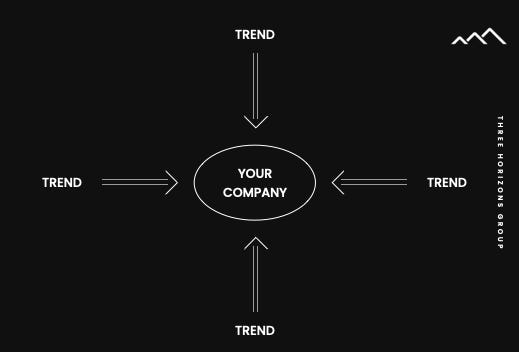Hey there.
Today’s newsletter is focused on positioning, specifically within the context of positioning a brand, product, or company (which is often the same thing).
Like several of the core components of brand marketing, positioning often gets overlooked, despite being a key part of the marketing lexicon since the 1980 classic titled… Positioning).
Why? Because nobody is demanding that you do it.
A customer isn’t going to demand that you deliver your positioning strategy to them by a certain date, but they will most certainly ask that you fix whatever might be wrong with your product ASAP.
Startups are so focused on the short term (burn rate, closing deals, raising funds, fixing problems), and they need to be, but one side-effect of this is that this important, foundational work that never comes with a due date attached is skipped over. It is never urgent. More timeless than timely.
And even when positioning is undertaken by a company, it is often done ineffectively (not incorrectly, as there is more than one right way to do it).
Positioning is a topic that I have covered quite a bit before, and today’s focus was inspired by my holiday reread of April Dunford’s first book, Obviously Awesome. She’s among the best B2B marketers I have come across, with applicable frameworks and the success and experience to back it up.
Thanks as always for reading, and please spread the word to any companies or marketers who would benefit.
Let’s get to it.
Jeff
How to position your company
I always like to first context-set with definitions. From April:
Positioning defines how your product is the best in the world at delivering SOME VALUE that a WELL-DEFINED SET OF COMPANIES/CUSTOMERS cares a lot about.
Value, well-defined, and set of companies/customers are the key terms here.
Figure out your actual value and translate that into a specific target market who cares. A lot. The a lot is important - don’t focus on all of your customers, but pick the ones who use and love you the most. The ones who need what you have and are willing to pay for it, not just the ones who may want it, or are already using it for free.
Great positioning is a “do it right once, benefit many times” activity (like much of brand marketing). Great positioning shortens sales and fundraising cycles and raises the effectiveness of all marketing and communications.
But knowing this and doing the work remains a gap for many. One reason is the lack of urgency around it. Another? It is hard work and takes time. Something that doesn’t seem urgent and is hard work? Good luck getting people to prioritize that.
Some non-negotiables required to get started with positioning:
Create the space (time, resources, and people) to undertake this exercise. There is no one right answer, but I’d suggest at least 3-4 meetings over a month, with key leaders from sales, product, marketing, and customer support/success involved (and of course the founder/founding team).
Set a quarterly meeting to review and iterate on the positioning as needed. It is not a set-it-and-forget-it activity.
Have one person accountable for documenting, sharing, and owning the positioning. Usually, but not always, your lead marketer.
Use words that your customers use. No fluff, buzzwords, or sales speak (unless, for some reason, these are commonplace in your target market).
The components of positioning
This list is taken right from April’s book and is the exact outline I rely on at the outset of conducting a positioning exercise:
Definite the competitive alternatives. Not just the direct competitors, but every single way a customer may do the thing that your product does.
What are your differentiated features? This is where it is important to build a very strong understanding of your competitors, both direct and indirect.
Translate these features into value for your customers. This is the “so what?” Talk to your current customers, especially your happiest and best users. Find out what they like and value, and see if this aligns with your differentiated features.
What market category are you in? Head to head against an incumbent? Challenger brand? Creating a new category to win? I used to lean into creating new categories, and still do if it makes sense, but this is often a longer-term play and makes the sales process more educational (you are not only selling a product or service, but a new category as well).
Who cares about what you are doing? What are the characteristics of your best customers? Like number three, this requires talking to your customers (again, focus on your happiest and best ones).
Each of these depends on the other, and they are best sequenced in the above order.
Figure out what you “actually sell”
This July 2013 internal memo from Slack Founder Stewart Butterfield is still a go-to share for all companies I work with: “We Don’t Sell Saddles Here.”
Just as much as our job is to build something genuinely useful, something which really does make people’s working lives simpler, more pleasant and more productive, our job is also to understand what people think they want and then translate the value of Slack into their terms.
The premise of this memo is to articulate the importance of properly positioning features as value for customers. This is particularly important for technology and software but applies to basically any company in any industry.
A central thesis is that all products are asking things of their customers: to do things in a certain way, to think of themselves in a certain way — and usually that means changing what one does or how one does it; it often means changing how one thinks of oneself.
This is another way of saying that customer empathy is important, and it should be a factor in your positioning. Slack is a great example of the power of effective positioning early on, as it unlocked the product-led growth that led to its incredible success, and eventual $27 billion exit in 2020 (seven years after this memo).
Lean into macro and cultural trends
Ideally, your company can ride the tailwinds of at least one, and ideally two to four macro, cultural-level trends. Some examples include consumer adoption of AI, global warming, anti-obesity medication, the aging population, and hybrid and remote working.
Don’t do this disingenuously (if you aren’t using AI, don’t lean into it), but you need to generate momentum in any way possible, and positioning your product/company as a solution to something that people care about at a rapidly increasing rate is a great way to add some external fuel.
Draw your company within a circle at the center of a page. Then, draw four arrows leading externally into the company, and find the four most relevant macro trends that are (or potentially could be) a fit.
I wouldn’t do this as the first step with your positioning exercise, but I wouldn’t save it until the end either. Instead, use it as a filter to evaluate your positioning to ensure your company is speaking to the most relevant and interesting markets.
The positioning deliverable
Here are three useful qualitative criteria to use when evaluating your positioning strategy:
When positioning is done well, it feels obvious. This is more qualitative than quantitative, more art than science, but I have found that the ‘gut check’ is the ultimate measure of evaluating positioning. When you have something you like, share it internally, with key stakeholders and customers. Does it resonate?
Is there complete alignment on it throughout the company? Does everybody agree with and understand it? Can they recite it? Does it resonate with your best customers? You won’t get 100% universal buy-in, but the key people need to agree on where you ended up.
When a qualified prospect hears it, do they lean in with questions and interest?
You don’t need to issue a press release or external announcement that your positioning is complete. Instead, you should end up with a concise, internal one-page memo with all of the relevant information, and no added fluff. Once this is done, it is time to bring your positioning to life in everything you do (website copy, investor decks, sales collateral, PR and media outreach, and so on). It fits into the strategic narrative you create for your company and brand, and one that you need to tell to the market in a consistent and compelling way.
Thanks for reading and happy positioning.
Jeff





